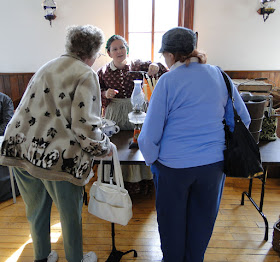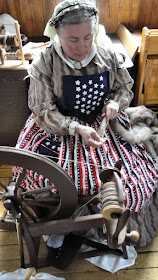That's kind of a long time, wouldn't you say?
And Eastpointe is in the County of Macomb.
Nothing too special there either. Except that this year of 2018 marks the 200th anniversary of Macomb County becoming a county.
Now that's kind of cool!
 And all the various local historical societies are celebrating this event. The historical imagination runs wild: in the year it became a county (1818), John Adams and Thomas Jefferson were still alive, James Madison was president, and the United States Congress adopted the American flag as having thirteen red and white stripes, and one star for each state (twenty at the time) with additional stars to be added as new states entered the union.
And all the various local historical societies are celebrating this event. The historical imagination runs wild: in the year it became a county (1818), John Adams and Thomas Jefferson were still alive, James Madison was president, and the United States Congress adopted the American flag as having thirteen red and white stripes, and one star for each state (twenty at the time) with additional stars to be added as new states entered the union.Even cooler, eh?
Named in honor of General Alexander Macomb, a highly decorated veteran of the War of 1812, Macomb County was the third county in the Michigan territory.
Here are a few historical bullet points about this county in which I've lived most of my life:
~ The
first Europeans arrived in the area during the 17th century. They included
French fur trappers (our Voyageur friends) who recognized the richness of the marshes and sought new
opportunities for trade.
~ Moravian missionaries established the first organized, non-native settlement in the county in 1782 as a refuge for Christianized Indians driven out of Ohio.
~ In the late 1790s, Christian Clemens visited the area, and in March of 1800, purchased a distillery considered the first building on the site of the future Mount Clemens. The next year he purchased 500 acres for development. This site, known as High Banks, was platted as the Village of Mount Clemens in 1818, when it was proclaimed the Macomb County Seat.
~ Moravian missionaries established the first organized, non-native settlement in the county in 1782 as a refuge for Christianized Indians driven out of Ohio.
~ In the late 1790s, Christian Clemens visited the area, and in March of 1800, purchased a distillery considered the first building on the site of the future Mount Clemens. The next year he purchased 500 acres for development. This site, known as High Banks, was platted as the Village of Mount Clemens in 1818, when it was proclaimed the Macomb County Seat.
~ In
the early 1800s, and at least by 1840, settlers moved into the interior of the
county, carving out farms from the hardwood forests. The roots of the county
villages and townships were established by this time. In addition to the
original French and English, later settlers included Germans, Belgians and
others who came directly from Europe.
~ And in
the 1870s, mineral baths brought international fame to Mount Clemens. Many
believed the waters had healing powers. Although the stream still runs beneath
the city, interest in the spas died out in the early 20th century. Recently,
there has been a reemergence of interest in the mineral baths now being offered
at St. Joseph Hospital in Mount Clemens.
So the East Detroit Historical Society asked the members of the 21st Michigan Civil War reenacting unit if we might be willing to help them celebrate by presenting living history at the old 1872 school house, knowing that we have the means to show everyday life of the mid-19th century inhabitants of this county of Macomb.
Why, of course we would!
Won't you join us?
Imagine stopping at the red light on the busy street (9 Mile Rd) directly in front of the school house and seeing this scene...
To date, about 800 Civil War soldiers who were from Macomb County have been identified - not bad for a very rural county of the 1860s (click HERE for more info).
The plan I put in use for our celebration of the history here was to have our Civil War military outside of the building, and the 'home arts' set up inside.
We also had a young lady who played a role in the military join us - Miss Annie Etheridge.
On the inside - - - - - -
Home arts was represented as well...
For a variety of reasons, we didn't get nearly as many visitors as we would have liked to, but all of us living historians who participated certainly enjoyed our time together after the long, cold winter separation, for we are all good friends whether we dress in period or modern clothing.
It was a fine start to what promises to be a wonderful reenacting season.
Until next time, see you in time.
So the East Detroit Historical Society asked the members of the 21st Michigan Civil War reenacting unit if we might be willing to help them celebrate by presenting living history at the old 1872 school house, knowing that we have the means to show everyday life of the mid-19th century inhabitants of this county of Macomb.
Why, of course we would!
Won't you join us?
Imagine stopping at the red light on the busy street (9 Mile Rd) directly in front of the school house and seeing this scene...
To date, about 800 Civil War soldiers who were from Macomb County have been identified - not bad for a very rural county of the 1860s (click HERE for more info).
The plan I put in use for our celebration of the history here was to have our Civil War military outside of the building, and the 'home arts' set up inside.
We also had a young lady who played a role in the military join us - Miss Annie Etheridge.
 |
| Andy the "eggman" spoke of his life on his chicken farm. During our reenactments, he really does walk around the camps to sell eggs to reenactors. |
 |
| I also brought a few of my farming tools such as the scythe you see me holding and the wood rake my son has, along with a few other implements like a flail and sickle. |
On the inside - - - - - -
 |
| - - - - we had mostly the 'home arts' - showing the life of most Macomb County women of the period. |
Yes, I am very proud of our civilians and how everyday life is presented in varying ways, including a woman who was assigned as the primary lighthouse keeper when her husband left for military service.
Anastasia “Eliza” Truckey served as lighthouse keeper of the Marquette Harbor Lighthouse in Marquette, Michigan, while her husband was away for war. Nelson Truckey left Eliza and their four children for three years to fight with the 27th Michigan Infantry during the Civil War. During that time, Eliza kept the light burning without an assistant to help her.
Anastasia “Eliza” Truckey served as lighthouse keeper of the Marquette Harbor Lighthouse in Marquette, Michigan, while her husband was away for war. Nelson Truckey left Eliza and their four children for three years to fight with the 27th Michigan Infantry during the Civil War. During that time, Eliza kept the light burning without an assistant to help her.
Laura Smith Haviland was a pioneer social activist who devoted her life to others. In 1837 she co-founded, with her husband Charles, the Raisin Institute, which was one of the first schools in the United States to admit black students. Laura Haviland was very involved in an anti-slavery movement, serving as Superintendent and Stationmaster on the Underground Railroad in Michigan.
After the Civil War, she became an officer in the Freedman’s Aid Society, assisting in the relocation and adjustment of former slaves in Kansas.
Mrs. Haviland also worked for the temperance movement.
Home arts was represented as well...
 |
| That's my wife on the left, and 21st Michigan member Sue on the right, and both had their wheels a-goin.' There was also knitting, crocheting, and sewing. |
 |
| And next to my wife we continue the home arts part of the tour - - - |
 |
| By the mid-19th century, oil lamps had made inroads to home-lighting, though candles were still pretty prominent, especially in the more rural areas. Here you see both - - - |
 |
| I see a chamber pot, candle mold with candles, an oil lamp (an antique from the 1880s), a butter paddle, a butter churn, and an ice cream maker. |
 |
| President Abraham Lincoln never actually traveled to Macomb County (or even to Michigan, from what I understand), but he wanted to make sure he was part of our celebration here in 2018! And he certainly was! Of course, it helps to have the finest Abraham Lincoln interpreter in the country as part of our reenacting unit! And Mr. Priebe is second to...um...to only the actual President Lincoln! |
 |
| "I wonder of the changes this county may see in future times, Mrs. Fleishman." "Things we cannot even dream of, I am sure, Mrs. Assenmacher!" |
 |
| My son, Robbie, enjoys playing period music on his fife. He's pretty darn good at it, too! |
 |
| Robbie and Jillian: good friends in a great hobby~ Rob kind of has the Jack White in Cold Mountain look going on here, don't you think? |
It was a fine start to what promises to be a wonderful reenacting season.
Until next time, see you in time.
~ ~ ~











No comments:
Post a Comment